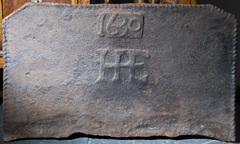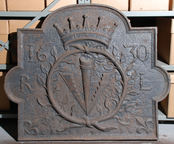-
1229
Description: Rectangular with canted top corners; twisted rope edging (top and sides); top centre, date formed from a single stamp, over-pressed; monogram below date.
Notes: Dates formed from a single stamp are uncommon, this series being distinguished by this practice. Formerly at a house in Rochester. Bentley Auctioneers, Cranbrook, lot 889, 4 Jun 2022 (£130).
Inscription: 1630 / HPE
- Decoration tags:
- rectangular with canted top corners (shape)
- rope (edging)
- carved stamps
- date stamp
- monogram
- text
Manufactured: in 1630 in the Weald area of England.
Current location: not known.
- Attached to series:
- 1630s HPE series
-
1177
 ? x ? mmImage subject to copyright
? x ? mmImage subject to copyrightDescription: Canted rectangular shape; twisted rope edging (top and sides); top centre, inscription 'C1630C'.
Notes: In the inscription, the letter 'C' may have been formed from a horseshoe. The fireback was discovered in 1959 at the works of Samuel Lewis & Co. Ltd. at Netherton, Worcestershire. It has been suggested that it was probably made by Walter Chetwynd, tenant of the ironworks at Cannockwood in Staffordshire who is mentioned as such in accounts of 1636 and 1637 made by Roger Jones received for William, Lord Paget of Beaudesert, the owner of the works.
Inscription: C1630C
- Decoration tags:
- rectangular with canted top corners (shape)
- rope (edging)
- simple stamps
- carved stamps
Manufactured: in 1630 possibly in the Cannock Chase area of England.
Current location: not known.
- Attached to series:
- Date & initials firebacks
-
324
Description: Rectangular with two-stepped top; undefined edging; in arch, stamp formed of a talbot statant guardant upon a wreath; date below crest; vertical carved billet stamped three times, the centre one higher than the other two, between the initials, below each pair of which is a cross stamp.
Notes: The talbot crest is seen on other firebacks indicating a common source; from a drawing in report 2553 of the Domestic Buildings Research Group (Surrey). The fireback is obscured behind a stove.
Inscription: 16 30 / IM EM
- Decoration tags:
- stepped (shape)
- simple stamps
- carved stamps
- heraldic
- text
- objects
Manufactured: in 1630 in the Weald area of England.
Current location: in private hands, Horne, Surrey, England.
- Attached to series:
- Talbot crest series
- Stepped firebacks
-
1311
Description: Rectangular with three arches; twisted rope edging (top and sides); in each of the two outer arches, initials 'WKE' in triad; in the central arch, which is higher than the two outer ones and bordered at the base by twisted rope, the date 1630.
Notes: The triple arched form is unusual. The initials are presumed to refer to a husband and wife whose surname began with 'K'
Inscription: 1630 / WKE [triad] WKE [triad]
- Decoration tags:
- rectangular with three arches (shape)
- rope (edging)
- carved stamps
- individual letters
- individual numbers
- text
Manufactured: in 1630 possibly in the Shropshire area of England.
Current location: Castle Lodge, Castle Square, Ludlow, Shropshire, England.
Citation: Moran, M., 2003, Vernacular Buildings of Shropshire (Almeley, Logaston Press).
- Attached to series:
- Date & initials firebacks
-
529
Description: Rectangular with three arches, the middle one larger than the outer two; cavetto-moulded edging; bottom panel, pictorial scene of Jesus and the woman of Samaria at the well (John 4), with other figures, buildings etc. in the background, illegible text below; centre arch, shield, helm, crest and mantling of unidentified arms, the initials 'GP' in bottom corners; left arch, probable figure of a saint; right arch, probable figure of a soldier. Mitford collection, Petworth House.
Notes: The combination of a biblical scene (John 4) with a coat of arms.
Inscription: 16 30 / G P
- Decoration tags:
- rectangular with three arches (shape)
- cavetto (edging)
- whole carved pattern
- pictorial
- biblical
- armorial
- text
- humans
Manufactured: in 1630 possibly in the Eifel area of Germany.
Current location: Petworth House, Petworth, West Sussex, England.
Museum number: NT/PET/M/83 (part of the National Trust museum group)
- Attached to series:
- New Testament firebacks
- Foreign armorial firebacks
-
691
Description: Arched rectangle; arch with egg and dart, ovolo edging, resting on rectangle shoulders and sides with triple fillet edging, a single fillet edged panel beneath; bottom panel, guilloche pattern of 12; main panel: shield, helm, crest, coronet and mantling of the Wynter/Wintour family of Lydney, Gloucestershire; the initials above the date, both split by the helm and coronet; on either side of the shield, Ionic pilasters; above the rectangle shoulders, a scrolled bracket each side, supporting the arch.
Notes: Wynter: Sable, a fess ermine, in chief a crescent for difference; crest: out of a ducal coronet, or, a cubit arm in armour erect, proper, garnished of the first, in the gauntlet three ostrich-feathers. The arms are likely to be those of Sir John Wynter, who owned several furnaces in the Forest of Dean. Formerly at Watts House, Bishop's Lydeard, Somerset, and before that at The Priory, Taunton.
Inscription: I W / 16 30
Arms: Winter/Wintour of Lydney, Gloucestershire
- Decoration tags:
- rectangular with round arch (shape)
- ovolo, egg and dart (edging)
- whole carved pattern
- individual letters
- individual numbers
- armorial
- text
Manufactured: in 1630 in the Forest of Dean area of England.
Current location: Horniman Museum, 100 London Road, Forest Hill, London, England.
Museum number: 6.249 (part of the Horniman Museum museum group)
- Attached to series:
- Personal armorial firebacks
-
588
Description: Arched rectangular shape with semi-circular protrusions at the sides; cavetto-moulded edging; a pheon (a downward-pointing arrow head barbed on the inner edge) within a wreath, an earl’s coronet above; the date on either side of the coronet; the initials on left and right sides; a fleur de lys in each bottom corner.
Notes: The detail of the wreath differs from that on the 1626 plate.
Copies of this fireback are known.
Inscription: 16 30 / R L
- Decoration tags:
- rectangular with round arch (shape)
- cavetto (edging)
- whole carved pattern
- heraldic
- text
- objects
Manufactured: in 1630 possibly at Robertsbridge Furnace, Salehurst in the Weald area of England.
Current location: Winchester Museums Store, Unit F2, Bar End Industrial Estate, Winchester, Hampshire, Winchester, Hampshire, England.
Museum number: WINCM:LH 5704 (part of the Winchester Museums museum group)
- Attached to series:
- Earl of Leicester series
- Personal firebacks
-
802
Description: Arched rectangular shaped; astragal edging (top and sides); mainly symmetrical vine arrangement, emerging from a vase, some fronds ending in an eagle’s head, other in leaves; at top of arch, initials ‘HB’ split by date (reversed) with an additional ‘I’; below, initials ‘AIS’ (reversed).
Notes: Two planklines; ‘HB’ refers to Henry Bell, who acquired Rake Manor, Witley, in 1592. ‘AIS’ refers to Anthony Smith, his nephew and heir, and his wife, Joan (née Hore); the form of the date is confused by the addition of an ‘I’, and the somewhat clumsy arrangement of the inscription suggests that it was added to the otherwise foliate pattern priot to casting. The letter 'H' seems to belong to a different character set
Copies of this fireback are known.
Inscription: H I0361B / AIS
- Decoration tags:
- rectangular with round arch (shape)
- astragal (edging)
- whole carved pattern
- planklines
- pictorial
- text
- plants
Manufactured: in 1630 possibly at Witley Park Furnace in the Weald area of England.
Current location: Rake Manor, Witley, Surrey, England.
Citation: Giuseppi, M. S., 1903, 'Rake in Witley [etc.]', Surrey Archaeological Collections, 18, pp. 11-60.
- Attached to series:
- Personal firebacks
- Miscellaneous pattern firebacks

.jpg)




